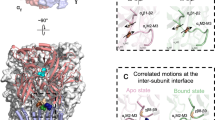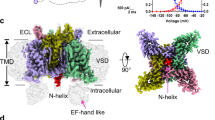Abstract
THE ionic channel associated with the acetylcholine (ACh) receptor at the neuromuscular junction of skeletal muscle fibres is probably the best described channel in biological membranes. Nevertheless, the properties of individual channels are still unknown, as previous studies were concerned with average population properties. Macroscopic conductance fluctuations occurring in the presence of ACh were analysed to provide estimates for single channel conductance and mean open times1–3. The values obtained, however, depended on assumptions about the shape of the elementary conductance contribution—for example, that the elementary contribution is a square pulse-like event2. Clearly, it would be of great interest to refine techniques of conductance measurement in order to resolve discrete changes in conductance which are expected to occur when single channels open or close. This has not been possible so far because of excessive extraneous background noise. We report on a more sensitive method of conductance measurement, which, in appropriate conditions, reveals discrete changes in conductance that show many of the features that have been postulated for single ionic channels.
This is a preview of subscription content, access via your institution
Access options
Subscribe to this journal
Receive 51 print issues and online access
$199.00 per year
only $3.90 per issue
Buy this article
- Purchase on Springer Link
- Instant access to full article PDF
Prices may be subject to local taxes which are calculated during checkout
Similar content being viewed by others
References
Katz, B., and Miledi, R., J. Physiol., Lond., 224, 665–699 (1972).
Anderson, C. R., and Stevens, C. F., J. Physiol., Lond., 235, 655–691 (1973).
Ben Haim, D., Dreyer, F., and Peper, K., Pflu¨gers Arch. ges. Physiol., 355, 19–26 (1975).
Stockholm, A., J. gen. Physiol., 44, 1073–1087 (1961).
Frank, K., and Tauc, L., in The Cellular Function of Membrane Transport (edit. by Hoffman, J.) (Prentice Hall, Englewood Cliffs, New Jersey, 1963).
Neher, E., and Lux, H. D., Pflu¨gers Arch. ges. Physiol., 311, 272–277 (1969).
Fishman, H. M., Proc. natn. Acad. Sci. U.S.A., 70, 876–879 (1973).
Takeuchi, A., and Takeuchi, N., J. Neurophysiol., 22, 395–411 (1959).
Betz, W., and Sakmann, B., J. Physiol., Lond., 230, 673–688 (1973).
Neher, E., and Sakmann, B., Pflu¨gers Arch. ges. Physiol., 355, R63 (1975).
Dreyer, F., Walther, Ch., and Peper, K., Pflu¨gers Arch. ges. Physiol., 359, R71 (1975).
Neher, E., and Sakmann, B., J. Physiol., Lond. (in the press).
Hladky, S. B., and Haydon, D. A., Nature, 225, 451–453 (1970).
Katz, B., and Miledi, R., J. Physiol., Lond., 230, 707–717 (1973).
Colquhoun, D., Dionne, V. E., Steinbach, J. H., and Stevens, C. F., Nature, 253, 204–206 (1975).
Author information
Authors and Affiliations
Rights and permissions
About this article
Cite this article
NEHER, E., SAKMANN, B. Single-channel currents recorded from membrane of denervated frog muscle fibres. Nature 260, 799–802 (1976). https://doi.org/10.1038/260799a0
Received:
Accepted:
Published:
Issue Date:
DOI: https://doi.org/10.1038/260799a0
This article is cited by
-
Organellar electrophysiology: DNA nanodevices charging at the unmeasured
BMC Biology (2024)
-
Multimodal Nature of the Single-cell Primate Brain Atlas: Morphology, Transcriptome, Electrophysiology, and Connectivity
Neuroscience Bulletin (2024)
-
Patch-seq: Advances and Biological Applications
Cellular and Molecular Neurobiology (2024)
-
Neuronal growth on high-aspect-ratio diamond nanopillar arrays for biosensing applications
Scientific Reports (2023)
-
Structural and functional imaging of brains
Science China Chemistry (2023)
Comments
By submitting a comment you agree to abide by our Terms and Community Guidelines. If you find something abusive or that does not comply with our terms or guidelines please flag it as inappropriate.



